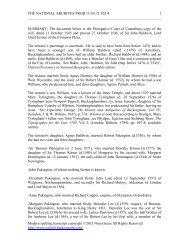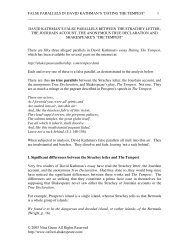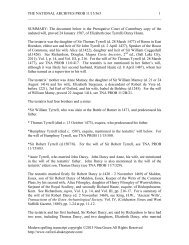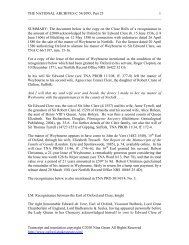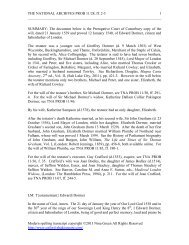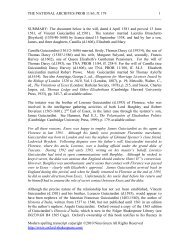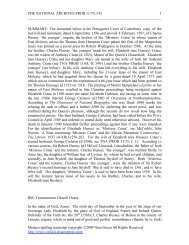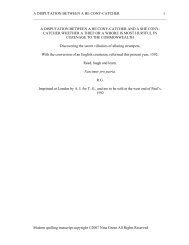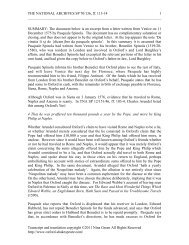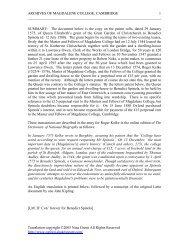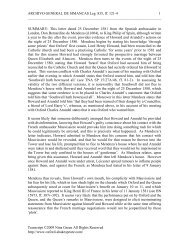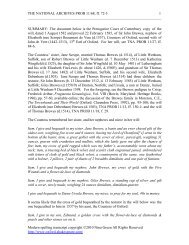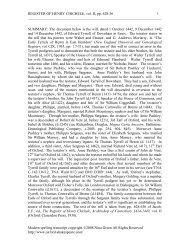Langham/ Mercer (30) - The Oxford Authorship Site
Langham/ Mercer (30) - The Oxford Authorship Site
Langham/ Mercer (30) - The Oxford Authorship Site
You also want an ePaper? Increase the reach of your titles
YUMPU automatically turns print PDFs into web optimized ePapers that Google loves.
Was the author of the <strong>Langham</strong> Letter a <strong>Mercer</strong><br />
and a Merchant-Adventurer?<br />
In the final paragraph of the Letter, the author indeed<br />
makes these claims. He signs himself:<br />
Yoor countreeman, companion, and freend assuredly:<br />
<strong>Mercer</strong>, Merchauntaventurer, and Clark of the Councell<br />
chamber doore, and allso kepar of the same: El<br />
prencipe negro. Par me. R.L. Gent. <strong>Mercer</strong> (Kuin<br />
80).<br />
<strong>The</strong> author thus offers three significant clues to his<br />
identity: he claims to be a <strong>Mercer</strong>, a Merchant-Adventurer,<br />
and both Clerk and Keeper of the Council<br />
Chamber Door. But can these claims be relied upon?<br />
Was there a real-life Robert <strong>Langham</strong> who was a<br />
<strong>Mercer</strong>, a Merchant-Adventurer, and both Clerk and<br />
Keeper of the Council Chamber Door?<br />
<strong>The</strong> answer seems to be that no person who was all<br />
three things ever existed, and that the Keeper of the<br />
Council Chamber is one individual named Robert<br />
<strong>Langham</strong>, the <strong>Mercer</strong> is an entirely different Robert<br />
<strong>Langham</strong>, and the Merchant-Adventurer is the<br />
anonymous author himself.<br />
<strong>The</strong>re is no dispute about the fact that there was a<br />
real-life Robert <strong>Langham</strong> who held the position of<br />
Keeper of the Council Chamber. Scott has discovered<br />
several Privy Council warrants authorizing payment<br />
to Robert <strong>Langham</strong> of an annual stipend of<br />
£10 for the years 1573-1578 and 1580 for services<br />
as "Keeper of the [Privy] Council Chamber", a position<br />
which included such duties as:<br />
EDWARD DE VERE<br />
NEWSLETTER NO. <strong>30</strong><br />
Published by De Vere Press<br />
1340 Flemish Street<br />
Kelowna, B.C. V1Y 3R7 Canada<br />
provision of bowghes and flowers . . . a fier shovell,<br />
peyer of tonges, bellowse and forke for that Chamber<br />
(Scott 299).<br />
<strong>The</strong>se Privy Council warrants clarify two points.<br />
Firstly, Robert <strong>Langham</strong> was not the "Clark of the<br />
Councell chamber doore". <strong>The</strong> title held by the reallife<br />
Robert <strong>Langham</strong> was "Keeper of the Council<br />
Chamber". <strong>The</strong> author's use of the title "Clark", an<br />
entirely different position from that of "Keeper", and<br />
one requiring a superior education, appears to be<br />
both facetious and deliberately misleading. Someone<br />
who held the position of a clerk would hardly<br />
be found busying himself outside the Council Chamber<br />
door, as <strong>Langham</strong> says he does in the Letter:<br />
Noow syr, if the Councell sit, I am at hand, wait at an<br />
inch I warrant yoo. If any make babling, peas (say I)<br />
wot ye whear ye ar? If I take a lystenar, or a priar in at<br />
the chinks, or at the lokhole, I am by and by in the<br />
bonez of him: but noow they keep good order, they<br />
kno me well inough: If a be a freend, or such one az I<br />
like, I make him sit doun by me on a foorm, or a cheast,<br />
Let the rest wallk a Gods name (Kuin 77-8).<br />
<strong>The</strong>se lines cannot be interpreted as a straight-faced<br />
description by Robert <strong>Langham</strong> himself of the bustling<br />
and officious manner in which he "guards" the<br />
Privy Council Chamber door. <strong>The</strong>y seem rather to<br />
be the amused observations of an anonymous author<br />
who is enjoying a jest at Robert <strong>Langham</strong>'s expense.<br />
<strong>The</strong> Privy Council warrants also make clear the menial<br />
nature of <strong>Langham</strong>'s duties, and the fact that his<br />
salary was a mere £10 per annum. None of this is<br />
consonant with claims that the Keeper of the Coun-<br />
© August 1991, February 2001 Published Monthly
cil Chamber was also a <strong>Mercer</strong>.<br />
During the Elizabethan era, the <strong>Mercer</strong>s were foremost<br />
among the twelve great livery companies of<br />
London, trading principally in silks and other luxury<br />
fabrics (Herbert 237). A member of the <strong>Mercer</strong>s'<br />
Company was, almost by definition, a wealthy man.<br />
Is it realistic to suppose that a minor court official, a<br />
Keeper of the Council Chamber, was one of the<br />
wealthy members of this great livery company?<br />
At the beginning of the Letter, the author makes no<br />
such claim. He calls himself merely an "officer attendant<br />
in Coourt". <strong>The</strong> title page of the Letter reads:<br />
A letter whearin, part of the entertainment untoo the<br />
Queenz Maiesty, at Killingwoorth Castle, in warwik<br />
Sheer, in this soomerz Progress. 1575, iz signified:<br />
from a freend officer attendant in Coourt, untoo hiz<br />
freend a Citizen, and Merchaunt of London (Kuin 35).<br />
On the following page, the author identifies the<br />
friend who is a "Citizen, and Merchaunt of London".<br />
He is "my good freend, Master Humfrey Martin<br />
<strong>Mercer</strong>" (Kuin 36).<br />
<strong>The</strong>re is historical evidence of Humfrey Martyn's<br />
membership in the <strong>Mercer</strong>s' Company. He was admitted<br />
to the Company by patrimony in 1570 (Kuin<br />
13). But what of Robert <strong>Langham</strong>, Keeper of the<br />
Council Chamber? As Kuin remarks, the claim that<br />
<strong>Langham</strong> was a <strong>Mercer</strong> can be checked:<br />
while anyone could call himself a ‘citizen and merchant’,<br />
to call oneself, and one’s correspondent, (as<br />
the author does) a <strong>Mercer</strong> implies identification. For<br />
the <strong>Mercer</strong>s were, and are, one of the great Livery<br />
Companies of London; and such a reference can be<br />
checked (Kuin 12-3).<br />
<strong>The</strong> records of the <strong>Mercer</strong>s' Company reveal that a<br />
Robert <strong>Langham</strong> was admitted to the freedom of<br />
the Company in 1557 by apprenticeship. However,<br />
there is no evidence to prove that this person was<br />
Robert <strong>Langham</strong>, Keeper of the Council Chamber.<br />
In fact, Bradbrook is of the view that the two Robert<br />
<strong>Langham</strong>s were not one and the same (Scott <strong>30</strong>0),<br />
and that the author of the Letter, knowing that there<br />
was a Robert <strong>Langham</strong> who was a <strong>Mercer</strong>,<br />
delibertely conflated him with Robert <strong>Langham</strong>,<br />
Keeper of the Council Chamber.<br />
This brings us to a consideration of the third claim<br />
in the conclusion of the Letter, the claim that the<br />
Keeper of the Council Chamber was also a Merchant-Adventurer.<br />
This claim can also be checked<br />
against the historical records. If, as Kuin says, "to<br />
call oneself . . . a <strong>Mercer</strong> implies identification",<br />
even more so does calling oneself a Merchant-Adventurer.<br />
Queen Mary's Charter of Incorporation of the Merchant-Adventurers<br />
of England of February 26th,<br />
1555 lists the names of 101 individuals, including<br />
seven marquises, lords and earls; thirteen knights;<br />
ten London aldermen; and such rising political figures<br />
as Sir William Cecil and Nicholas Bacon (CPR<br />
1554-5, 55-59).<br />
Queen Elizabeth's Charter of Incorporation of the<br />
Governor, Assistants and Fellowship of Merchants<br />
Adventurers of England of July 18, 1564, lists only<br />
forty-nine names. However, a blanket provision at<br />
the end includes "all persons who have been admitted<br />
Freemen of the Company of Merchants Adventurers<br />
trading to Holland, Zealand or Flanders or<br />
should hereafter have been admitted by reason of<br />
patrimony or apprenticeship" (CPR 1563-6, 178-80).<br />
It is worth noticing that among the individuals named<br />
in Queen Elizabeth's charter are three persons related<br />
to Humfrey Martyn, the addressee of the Letter:<br />
his father, Sir Roger Martyn; his uncle, Lionel<br />
Duckett; and his relative by his father's second marriage,<br />
Edward Castelyn.<br />
<strong>The</strong> men named in both charters were prominent<br />
citizens and wealthy individuals, and the enterprises<br />
on which they were engaged demanded the expenditure<br />
of substantial sums of money. Queen Mary's<br />
Charter, for example, recites that the Merchant-Adventurers:<br />
have at their own adventure and costs provided, rigged<br />
and tackled certain ships, pinnaces and other vessels<br />
and have advanced them furnished with all things necessary<br />
to discover isles and lands unknown and not<br />
commonly frequented before this by the subjects of<br />
© August 1991, February 2001 Published Monthly
the crown, which shall chance them sailing northwards,<br />
north-westwards and north-eastwards or any part in<br />
that course which other Christian monarchies in league<br />
and amity with the king and queen have not heretofore<br />
by seas frequented, to attain by this adventure both<br />
the glory of God and the increase of the general wealth<br />
of the realms of the king and queen and their subjects<br />
(CPR 1554-5, 57).<br />
Was Robert <strong>Langham</strong>, Keeper of the Council Chamber,<br />
likely to have been a Merchant-Adventurer? <strong>The</strong><br />
available evidence suggests a negative answer. His<br />
station in life is incompatible with membership in<br />
this group; with his minor official position at court,<br />
he does not appear to have moved in the circle of<br />
commercial magnates who comprised the Company<br />
of Merchant-Adventurers. Moreover, he is not<br />
named in either of the Charters of Incorporation.<br />
This latter point does not completely rule him out<br />
because of the blanket provision covering past and<br />
future members contained in Queen Elizabeth's<br />
Charter of July 18, 1564, but on balance it seems<br />
highly unlikely that the Robert <strong>Langham</strong> who was<br />
Keeper of the Council Chamber was a Merchant-<br />
Adventurer.<br />
Interestingly, though, two of the four individuals to<br />
whom William Patten says he gave copies of the<br />
<strong>Langham</strong> Letter in September, 1575 -- William<br />
Cecil, Lord Burghley, and his brother-in-law<br />
Nicholas Bacon -- were Merchant-Adventurers.<br />
Both are named in Queen Mary's Charter of 1555.<br />
In addition, Lord Burghley's son-in-law, Edward de<br />
Vere, 17th Earl of <strong>Oxford</strong>, was, in a very practical<br />
sense, a merchant adventurer. Like other members<br />
of the nobility in the Elizabethan era, <strong>Oxford</strong> was a<br />
financial backer of voyages of exploration and trade,<br />
the most notable of these being Martin Frobisher's<br />
third voyage in search of the Northwest Passage and<br />
Captain Edward Fenton's 1582-3 voyage to the East<br />
Indies. <strong>Oxford</strong> invested £<strong>30</strong>00 in the former voyage<br />
and at least £500 in the latter (see issue #2 of<br />
the Edward De Vere Newsletter).<br />
Thus, on the balance of probabilities, the author of<br />
the <strong>Langham</strong> Letter who signs himself a<br />
"Merchauntaventurer" is far more likely to have been<br />
Edward de Vere, 17th Earl of <strong>Oxford</strong>, than Robert<br />
<strong>Langham</strong>, Keeper of the Council Chamber.<br />
<strong>The</strong> concluding paragraph of the <strong>Langham</strong> Letter<br />
thus allows us to see how the anonymous author used<br />
Robert <strong>Langham</strong>, Keeper of the Council Chamber,<br />
as a persona to cover his real identity. <strong>The</strong>re was a<br />
real-life Robert <strong>Langham</strong> who was Keeper of the<br />
Council Chamber, and it is this real-life Robert<br />
<strong>Langham</strong> who was intially delighted to receive a<br />
copy of the Letter, and who wanted more copies<br />
given to him. Later, perhaps because the Queen<br />
herself, and Leicester, were displeased with the<br />
jaunty tone of the Letter, and with the possibility<br />
that it might turn the "honourable entertainment" into<br />
a "jest", <strong>Langham</strong> "complained" about the book, and<br />
the first edition was entirely suppressed. All of this<br />
is consistent with the hypothesis that the real author<br />
of the Letter was Edward de Vere, 17th Earl of <strong>Oxford</strong>,<br />
who was hundreds of miles away in Italy in<br />
July 1575 when the Kenilworth entertainment took<br />
place, but who attempted to be there in spirit through<br />
the Letter.<br />
Works Cited<br />
Calendar of the patent rolls, Philip and Mary, 1554-1555. London:<br />
His Majesty's Stationery Office, 1936. (CPR 1554-5)<br />
Calendar of the patent rolls, Elizabeth, 1563-1566. London: Her<br />
Majesty's Stationery Office, 1960. (CPR 1563-6)<br />
Herbert, William. <strong>The</strong> history of the twelve great livery companies<br />
of London, principally compiled from their grants and records.<br />
2 vols. London, 1834.<br />
Kuin, R.J.P. Robert <strong>Langham</strong>: A letter. Leiden: E.J. Brill, 1983.<br />
Scott, David. “William Patten and the authorship of Robert<br />
Laneham’s Letter (1575)”. English Literary Renaissance 7<br />
(Spring 1977), 297-<strong>30</strong>6.<br />
© August 1991, February 2001 Published Monthly



